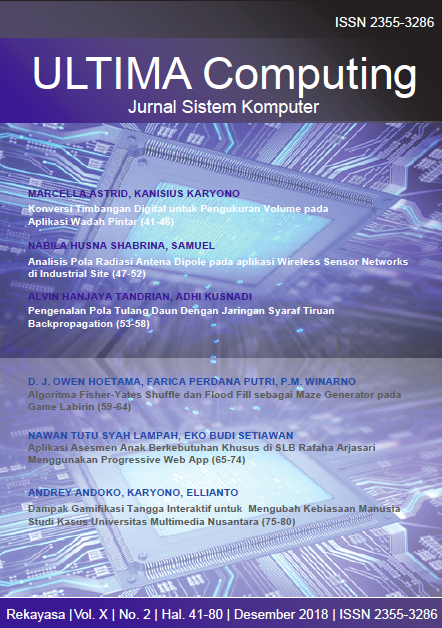Algoritma Fisher-Yates Shuffle dan Flood Fill sebagai Maze Generator pada Game Labirin
DOI:
https://doi.org/10.31937/sk.v10i2.1064Abstract
Maze game is an interesting game and used to spend time. However, in the maze game, the level used forthis game still uses static levels. Static levels make the maze shape stay the same if we play the same level. Thus, players will quickly feel bored because it finds the same complexity. Maze generator is a static level problem solution on the maze game. This research uses Fisher-Yates Shuffle algorithm and Flood Fill algorithm to make maze generator. Fisher-Yates Shuffle algorithm is used for wall position randomization and Flood Fill algorithm to keep the maze results to remain resolved. The results of the application implementation yielded 30 mazes and were tested using the Hamming Distance algorithm, yielding that the result of the maze formed is always different. The average percentage rate difference produced 48% each time the maze was formed. The results of the maze that was formed performed perfect maze checking with the result of 83.33% percentage.
Index Terms” Fisher-Yates Shuffle, Flood Fill, Maze
Generator, Hamming Distance
Downloads
Downloads
Published
How to Cite
Issue
Section
License
Authors retain copyright and grant the journal right of first publication with the work simultaneously licensed under a Creative Commons Attribution-ShareAlike International License (CC-BY-SA 4.0) that allows others to share the work with an acknowledgment of the work's authorship and initial publication in this journal.
Authors are able to enter into separate, additional contractual arrangements for the non-exclusive distribution of the journal's published version of the work (e.g., post it to an institutional repository or publish it in a book), with an acknowledgment of its initial publication in this journal.
Copyright without Restrictions
The journal allows the author(s) to hold the copyright without restrictions and will retain publishing rights without restrictions.
The submitted papers are assumed to contain no proprietary material unprotected by patent or patent application; responsibility for technical content and for protection of proprietary material rests solely with the author(s) and their organizations and is not the responsibility of the ULTIMA Computing or its Editorial Staff. The main (first/corresponding) author is responsible for ensuring that the article has been seen and approved by all the other authors. It is the responsibility of the author to obtain all necessary copyright release permissions for the use of any copyrighted materials in the manuscript prior to the submission.















